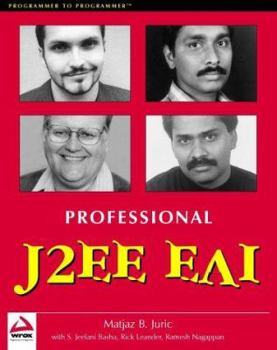Professional J2ee Eai
Enterprise Application Integration (EAI) has been the driving force behind application and information system development of the last few years. The Java 2 Platform, Enterprise Edition (J2EE) provides... This description may be from another edition of this product.
Format:Paperback
Language:English
ISBN:186100544X
ISBN13:9781861005441
Release Date:December 2001
Publisher:Wrox Press
Length:1000 Pages
Weight:3.37 lbs.
Dimensions:2.0" x 7.1" x 9.1"
Customer Reviews
5 ratings
Best book for J2EE 1.3 with EAI examples
Published by Thriftbooks.com User , 21 years ago
I bought this book exactly two months ago. It helped me to solve many problems associated with my current EAI project. The examples provided works well with BEA Weblogic 6.1. Especially the chapters on JMS, XML and handling transactions were very heplfull.I do some books on EAI and J2EE. But those books did'nt cover well Integration. I would recommend to everyone who is especially involved in J2EE based integration projects.
A good foundation for developing Web Services
Published by Thriftbooks.com User , 22 years ago
I found this book very useful for everyone who uses J2EE platform and has some existing applications in other technologies. The book gives in-depth overview of all possible approaches and technologies and the examples are good too. This book is for developers with some experience in J2EE and addresses some problems I couldn't find anywhere else. What I found particularly useful was the EAI architecture, which shows how to develop Web Services in J2EE and how to connect them with existing applications. This is exactly what my problem was!
Good J2EE book with EAI examples.
Published by Thriftbooks.com User , 22 years ago
I bought this book after a long search to find out J2EE component examples for JMS, XML, J2EE Connectors and XA transactions. Ofcourse this book solved my EAI problems using J2EE components.(+) Good examples on JMS, XML processing, J2EE connectors, JTA transactions and implementing custom security.(-) Theory chapters discussing why J2EE.Finally, It's a great book, worth reading for cut & paste EAI examples.
So much to learn from this book - buy it now!
Published by Thriftbooks.com User , 22 years ago
The book's first chapter introduces eai and an overview of j2ee technologies.Chapter 2 discusses choices and strategies when deciding on integrating applications. It can be quite dry and academic at times but worth reading. Many fundamental concepts are presented and provide the building blocks for the rest of the book. There is no real mention of j2ee or java in this chapter, the strategy is universal across different component models and architectures (j2ee, corba or .net).There are chapters on ;how j2ee could be used for eai.when in the project to integrate.what are the different techniques used to integrate.How can xml and messaging be used for eai.Modeling process using uml.There are two chapters focusing on corba and rmi-iiopChapter 12 shows how to integrate using ejb. This also covers using ejb 2.0, message-driven beans and cmp 2.0. The reader should be familiar with ejb, cmp, bmp and the value object design pattern.The book also has chapters on the j2ee connector architecture, windows com bridges, transaction management (ots, transaction api), security management, presentation and finally web services. The section on security and single sign-on is interesting.This book is aimed at java developers with a few years experience. You will need good knowledge of java and some knowledge of xml, uml and component architectures (CORBA, ejb). If you need to understand how to integrate your new j2ee solution to use existing (legacy or otherwise) applications then this is a good book to read.
Highly recommended
Published by Thriftbooks.com User , 22 years ago
This book provides comprehensive coverage on integration of existing applications (not only legacy, but also Microsoft COM+, CORBA, SAP R/3, etc) with J2EE platform. It covers all relevant J2EE technologies including CORBA, Java Connector Architecture, RMI-IIOP, EJBs, JMS, XML and others with code examples (that actually seem to work). Two chapters are devoted to transactions and security. The book even touches B2B integration (SOAP and Web Services). But best of all, the book does not focus on technologies only but provides guidelines on integration process, particularly on evaluation of existing applications. Currently it is the only book on this topic. Highly recommended for every J2EE developer!




